#early cretaceous
Text
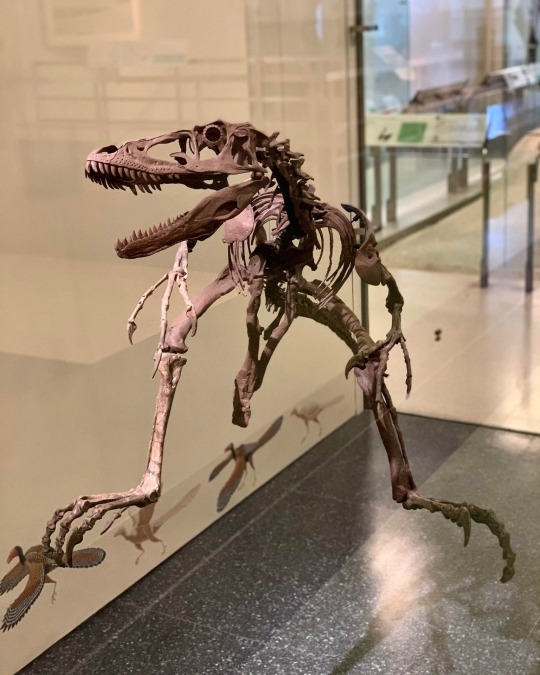
Happy Fossil Friday! With sharp teeth, long legs, and sickle claws, Deinonychus antirrhopus was likely a formidable predator. This dinosaur, which could reach lengths of about 7 ft (2.1 m) from nose to tail, lived during the Early Cretaceous, some 107 million years ago. It belonged to a group of dinosaurs called maniraptors, or “hand-robbers.” Its hands and feet were equipped with sharp claws for catching and grasping prey. Like modern-day birds, it had hollow bones.
Fun fact: The Deinonychus on display in the Museum is a real fossil skeleton—and the only one of its kind on display anywhere in the world! See it up close in the Hall of Saurischian Dinosaurs! We're open daily from 10 am-5:30 pm. Plan your visit.
Photo: © AMNH
#science#amnh#museum#fossil#dinosaur#nature#natural history#animals#paleontology#fossil friday#deinonychus#cretaceous period#early cretaceous#did you know#fact of the day#dinosaurs#cool animals#prehistoric animals
542 notes
·
View notes
Text
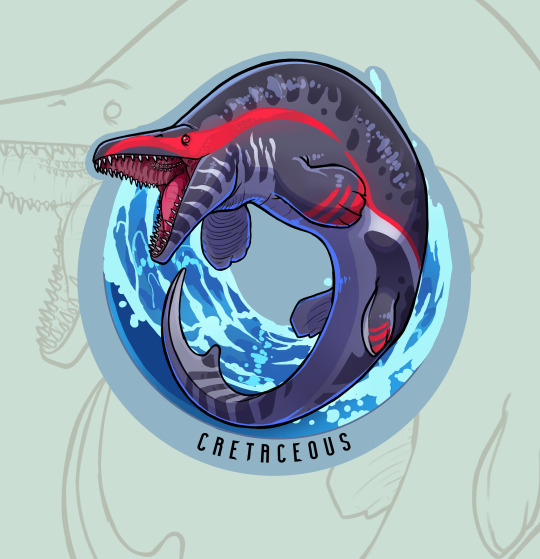
Apexpredator of the cretaceous oceans, Mosasaurus Hoffmanni
#illustration#digital art#art#aesthetic#illustrators on tumblr#animals#character design#dinosaur#paleoart#paleontology#paleoblr#paleomedia#artists on tumblr#dinosaurs#paleoposting#paleo tag#cretaceous period#late cretaceous#early cretaceous#mosasaur#jurassic park
364 notes
·
View notes
Text
Imparavis attenboroughi Wang et al., 2024 (new genus and species)

(Type specimen of Imparavis attenboroughi [scale bar = 20 mm], from Wang et al., 2024)
Meaning of name: Imparavis = odd bird [in Latin]; attenboroughi = for Sir David Attenborough [British documentary presenter and conservationist]
Age: Early Cretaceous (Aptian), between 119–123 million years ago
Where found: Jiufotang Formation, Liaoning, China
How much is known: Nearly complete skeleton of one individual preserved with feather traces.
Notes: Imparavis was an enantiornithean, a group of bird-like, flying dinosaurs from the Cretaceous. Although they would have looked a lot like modern birds, most enantiornitheans had teeth. Imparavis was an exception in that regard, being one of the few known toothless enantiornitheans. Prior to its discovery, the only other enantiornitheans confirmed to have been toothless were the Late Cretaceous Gobipteryx and Gobipipus from Mongolia and Yuornis from China, making Imparavis one of the oldest known enantiornitheans to lack teeth. (The describers of Imparavis additionally reinterpret another enantiornithean from the Jiufotang Formation, Chiappeavis, as toothless as well.)
Imparavis may have spent time both in trees and on the ground, based on details of its hindlimb anatomy. Its wing bones exhibit pronounced muscle attachment points, suggesting that it might have been capable of rapid, powerful take-offs.
Reference: Wang, X., A.D. Clark, J.K. O'Connor, X. Zhang, X. Wang, X. Zheng, and Z. Zhou. 2024. First edentulous enantiornithine (Aves: Ornithothoraces) from the Lower Cretaceous Jehol avifauna. Cretaceous Research advance online publication. doi: 10.1016/j.cretres.2024.105867
156 notes
·
View notes
Text
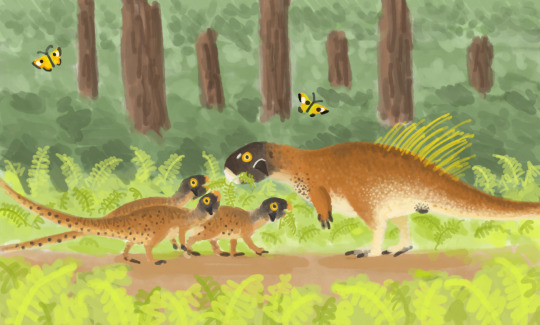
Mother Psittacosaurus with Chicks
#mother’s day#mothers day#psittacosaurus#dinosaur#paleoart#dinosaurs#cretaceous#early cretaceous#paleontology#ceratopsian
954 notes
·
View notes
Text
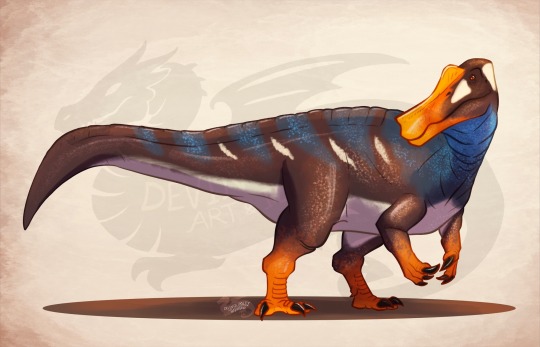
Paleovember 2023, Irritator challengeri !
Hailing from Brazil during the Early Cretaceous, this spinosaurid's name derives from the fact that it's nearly complete skull had been heavily damaged and altered by the collectors who found it (along with a reference to Professor Challenger in Sir Arthur Conan Doyle's The Lost World. ). Based on the remains we do have, Irritator leans on the smaller side for spinosaurids, estimated to be between 20 to 26 feet long. At the same time, though, the specimen was found to be a juvenile, so it potentially grew to be much larger as an adult.
#dinosaur#irritator#spinosauridae#early cretaceous#brazil#mesozoic#illustration#art#paleontology#paleoart#Paleovember#prehistoric#artwork#art challenge#procreate#artist on tumblr
154 notes
·
View notes
Text

#what da hell#what he doin on da rock#what da dog doin#wuh#huh?#I wasn’t eated don’t worry#dangeraffe didn’t eat me#I miss mister French fry#weird dog#weird dog series#tropeognathus#flocking#paleostream#pterosaur#cretaceous#late cretaceous#cretaceous period#early cretaceous#dunno which one#archosaur#anhangueridae#Brazil#rock
39 notes
·
View notes
Text
back on my paleo hyperfixation

22 notes
·
View notes
Text

Heyoooo! First post on this new sideblog.
As much as bearded vultures are not only my favorite dinosaur, but my favorite animal in general, I feel like non-avian dinosaur designs using bearded vulture colors and markings are extremely overdone. 😅 However… I am in the midst of making new avatars for all my blogs and I want them to all have the same theme (bearded vulture). Which I guess means I gotta put bearded vulture markings on another dino. For this, I have chosen Yutyrannus huali.
#Yutyrannus huali#Yutyrannus#tyrannosauroids#tyrannosaurid#theropods#saurishcians#dinosaurs#archosaurs#archosauromorphs#reptiles#Yixian Formation#Early Cretaceous#China
25 notes
·
View notes
Text
Throwback Thursday: Early Cretaceous Utah
What did it look like when the Cedar Mountain Formation was being deposited? Let's take a step back in time and she what Utah looked like 140-100 million years ago!

During the early Cretaceous, the Mowry Sea was just starting to inundate the continent (the Sundance Sea had retreated back into Canada before the Late Jurassic). The newly formed Sevier Mountains were in the western part of Utah and had many large rivers emptying from them to the northeast and into the Mowry Sea across broad, low-lying floodplains.

The Cedar Mountain Formation covers roughly 50 million years, It shows a change in climate from a semi-arid to humid. This change was heavily influenced by the transgression of the Mowry Sea.

#paleontology#fossils#geology#fun facts#dinosaur#cedar mountain formation#early cretaceous#utah#utahraptor#paleogeography
17 notes
·
View notes
Text

A Fukuisaurus in ancient Japan 120 million years ago.
15 notes
·
View notes
Text
Early Cretaceous Jiufotang Formation
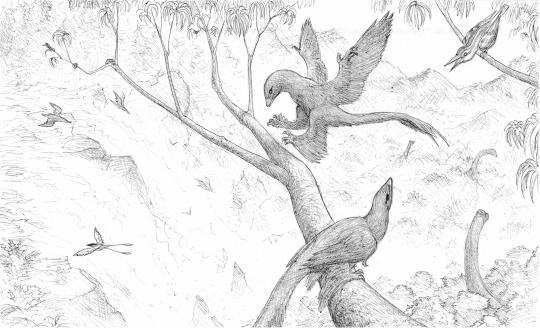
An illustration sketched with a ballpoint pen during my breaks at work (we've had a couple of slow days recently).
Based on some of the vertebrate fossils known from the Jiufotang Formation in China's Liaoning Province.
Foreground: several generic caterpillars, two Microraptor specimens, and a bird based on Longipteryx.
Background: one Confuciusornis, more Longipteryx-based birds, some generic titanosaurs.
#liaoning#china#early cretaceous#microraptor#confuciusornis#titanosaurs#longipteryx#enantiornithes#theropod#sauropod#feathered dinosaurs#birds#jiufotang formation#pen drawing#pen sketch#ballpointpen#paleoart#illustration#pen doodles
40 notes
·
View notes
Photo
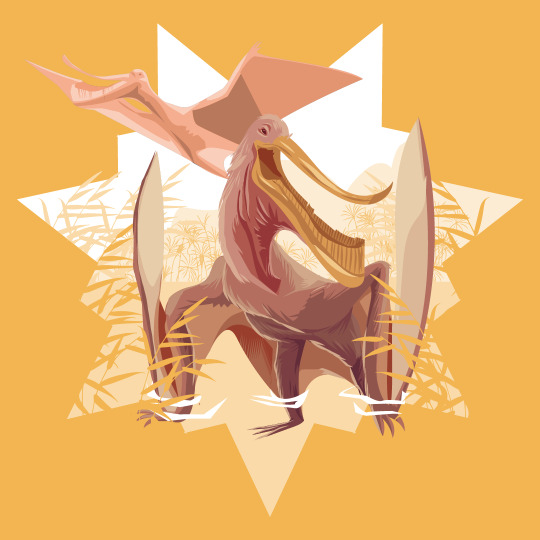
No dinosaurs #dinovember2022 day 18: Pterodaustro
#dinovember#pterodaustro#pterodactyl#ctenochasmatidae#early cretaceous#paleoart#paleoillustration#Illustration#vector#vectorart
38 notes
·
View notes
Text
Yanbeilong ultimus Jia et al., 2024 (new genus and species)
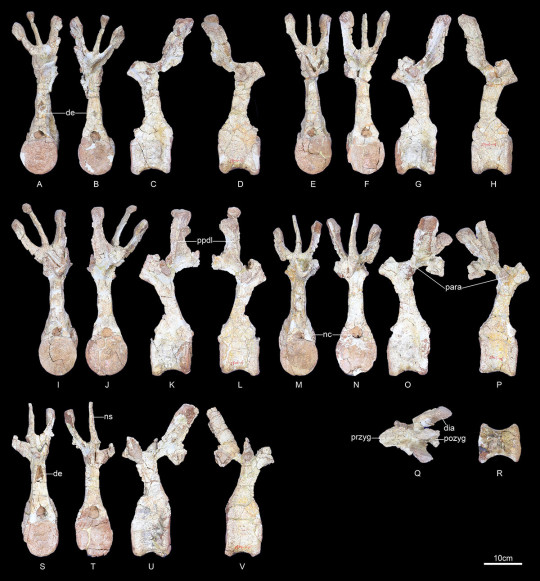
(Back vertebrae of Yanbeilong ultimus, from Jia et al., 2024)
Meaning of name: Yanbeilong = dragon north of Yanmen Pass [in Chinese]; ultimus = last [in Latin]
Age: Early Cretaceous (Albian)
Where found: Zuoyun Formation, Shanxi, China
How much is known: Partial skeleton of one individual including several vertebrae and most of the hip.
Notes: Yanbeilong was a stegosaur. Cretaceous fossils of stegosaurs are rare, and they are generally thought to have died out in the Early Cretaceous (though some controversial remains may suggest otherwise). Yanbeilong is thus one of the youngest uncontested stegosaurs known.
Reference: Jia, L., N. Li, L. Dong, J. Shi, Z. Kang, S. Wang, S. Xu, and H. You. 2024. A new stegosaur from the late Early Cretaceous of Zuoyun, Shanxi Province, China. Historical Biology advance online publication. doi: 10.1080/08912963.2024.2308214
148 notes
·
View notes
Text

Tyrannomimus fukuiensis finding ferns for building a nest
References: www.nature.com/articles/s41598…
http://www.nature.com/articles/s41598
#paleoart#dinosaur#dinosaurs#paleontology#tyrannomimus#dinosauria#dinosaur art#cretaceous period#early cretaceous
60 notes
·
View notes
Text
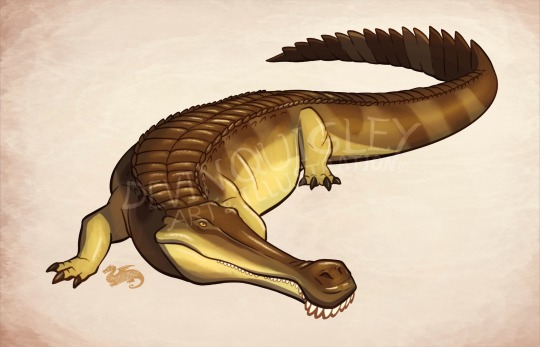
Paleovember 2023, Sarcosuchus!
Dating back to the Early Cretaceous, Sarcosuchus is a near-relative of modern crocodilians (not a true crocodilian itself) with species native to both Northern Africa and Brazil. The North African species, S. imperator, is estimated to measure up to 32 feet long! It's especially notable for the bulla, the large rounded portion of the end of the snout similar to the modern gharial. Unlike gharials, however, where the bulla is restricted to males, both sexes in Sarcosuchus seem to have a bulla, and while the gharial limits itself to eating fish, Sarcosuchus was more likely to be a generalist hunter of dinosaurs (though it wouldn't have been able to do the famous 'death roll' to rip it's prey apart).
#sarcosuchus#early cretaceous#pseudosuchia#crocodile#gharial#reptile#paleoart#paleontology#mesozoic#illustration#art#artwork#cartoon#digitalart#drawing#procreate#artist on tumblr
60 notes
·
View notes
Text

#don’t feed wild animals#mr french fry#keeps bothering me and my family#i’m in danger#help#please please please#uh oh#weird#weird horse#weird dog series#lacusovagus#azhadarchid#azhdarchoid#chaoyangopteridae#chaoyangopterid#pterosaur#Mesozoic#cretaceous#early cretaceous#crato formation#avemetatarsalia
42 notes
·
View notes